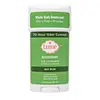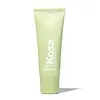What's inside
What's inside
 Key Ingredients
Key Ingredients

 Benefits
Benefits

 Concerns
Concerns

 Ingredients Side-by-side
Ingredients Side-by-side

Water
Skin ConditioningMandelic Acid
AntimicrobialMaranta Arundinacea Root Powder
Skin ConditioningTapioca Starch
Isoamyl Laurate
EmollientBehenyl Alcohol
EmollientHydrogenated Castor Oil
EmollientCaprylic/Capric Triglyceride
MaskingCaffeine
Skin ConditioningPvm/Ma Decadiene Crosspolymer
Potassium Hydroxide
BufferingGlyceryl Stearate
EmollientStearyl Alcohol
EmollientDimethicone
EmollientPanthenol
Skin ConditioningAloe Barbadensis Leaf Juice
Skin ConditioningTheobroma Cacao Seed Butter
EmollientTocopherol
AntioxidantAllantoin
Skin ConditioningStearic Acid
CleansingPalmitic Acid
EmollientCetyl Alcohol
EmollientLauryl Alcohol
EmollientMyristyl Alcohol
EmollientLecithin
EmollientPentylene Glycol
Skin ConditioningPhenylpropanol
MaskingSodium Benzoate
MaskingWater, Mandelic Acid, Maranta Arundinacea Root Powder, Tapioca Starch, Isoamyl Laurate, Behenyl Alcohol, Hydrogenated Castor Oil, Caprylic/Capric Triglyceride, Caffeine, Pvm/Ma Decadiene Crosspolymer, Potassium Hydroxide, Glyceryl Stearate, Stearyl Alcohol, Dimethicone, Panthenol, Aloe Barbadensis Leaf Juice, Theobroma Cacao Seed Butter, Tocopherol, Allantoin, Stearic Acid, Palmitic Acid, Cetyl Alcohol, Lauryl Alcohol, Myristyl Alcohol, Lecithin, Pentylene Glycol, Phenylpropanol, Sodium Benzoate
Water
Skin ConditioningAloe Barbadensis Leaf Juice
Skin ConditioningGlycerin
HumectantMandelic Acid
AntimicrobialPolyglyceryl-4 Cocoate
EmollientSodium Hydroxide
BufferingShikimic Acid
Skin ConditioningLactic Acid
BufferingPalmitoyl Tripeptide-5
Skin ConditioningHyaluronic Acid
HumectantCitric Acid
BufferingTartaric Acid
BufferingXanthan Gum
EmulsifyingPotassium Sorbate
PreservativeSodium Benzoate
MaskingCananga Odorata Flower Oil
MaskingCitrus Aurantium Amara Flower Oil
MaskingCitrus Paradisi Peel Oil
MaskingSimmondsia Chinensis Seed Oil
EmollientBenzyl Benzoate
AntimicrobialLimonene
PerfumingLinalool
PerfumingWater, Aloe Barbadensis Leaf Juice, Glycerin, Mandelic Acid, Polyglyceryl-4 Cocoate, Sodium Hydroxide, Shikimic Acid, Lactic Acid, Palmitoyl Tripeptide-5, Hyaluronic Acid, Citric Acid, Tartaric Acid, Xanthan Gum, Potassium Sorbate, Sodium Benzoate, Cananga Odorata Flower Oil, Citrus Aurantium Amara Flower Oil, Citrus Paradisi Peel Oil, Simmondsia Chinensis Seed Oil, Benzyl Benzoate, Limonene, Linalool
 Reviews
Reviews

Ingredients Explained
These ingredients are found in both products.
Ingredients higher up in an ingredient list are typically present in a larger amount.
Aloe Barbadensis Leaf Juice comes from leaves of the aloe plant. Aloe Barbadensis Leaf Juice is best known for helping to soothe sunburns. It is also anti-inflammatory, moisturizing, antiseptic, and can help heal wounds.
Aloe is packed with good stuff including Vitamins A, C, and E. These vitamins are antioxidants, which help fight free-radicals and the damage they may cause. Free-radicals are molecules that may damage your skin cells, such as pollution.
Aloe Barbadensis Leaf Juice also contains sugars. These sugars come in the form of monosaccharides and polysaccharides, folic acid, and choline. These sugars are able to help bind moisture to skin.
It also contains minerals such as calcium, 12 anthraquinones, fatty acids, amino acids, and Vitamin B12.
Learn more about Aloe Barbadensis Leaf JuiceMandelic Acid is an alpha hydroxy acid (AHA).
Like other AHAs, it helps exfoliate the surface of the skin by breaking down the bonds that hold dead skin cells together. This helps reveal smoother and brighter skin underneath.
Mandelic acid helps with:
Due to it having a larger molecular size than glycolic acid, mandelic acid is able to penetrate the skin more slowly and evenly. This makes it gentler and less irritating, making it a great option for sensitive or beginner skin.
Despite being milder, mandelic acid is still an effective exfoliant that improves skin texture and tone over time.
What makes mandelic acid stand out from other AHAs? It has antibacterial and antioxidant properties.
These traits make it a great option for acne-prone or problem skin by reducing active breakouts and fading post-acne marks. Studies show that mandelic acid (especially when combined with salicylic acid) can significantly reduce pimples and hyperpigmentation while causing fewer side effects than stronger acids.
Mandelic acid is effective in concentrations of 5% and up with an ideal pH range of 3-4 for at-home use.
Like other AHAs, it’s important to wear sunscreen daily to protect your newly exfoliated skin.
However, unlike glycolic acid, mandelic acid is light-sensitive. Be sure your mandelic acid is packaged in opaque containers to ensure it stays stable and effective.
In short, mandelic acid is a gentle yet powerful AHA that exfoliates, brightens, and helps clarify skin while keeping irritation low. Its antibacterial action makes it especially beneficial for those with acne-prone, sensitive, or uneven skin, offering smoother, clearer, and more even-toned results over time.
Read more about some other popular AHA's here:
Learn more about Mandelic AcidSodium Benzoate is a preservative. It's used in both cosmetic and food products to inhibit the growth of mold and bacteria. It is typically produced synthetically.
Both the US FDA and EU Health Committee have approved the use of sodium benzoate. In the US, levels of 0.1% (of the total product) are allowed.
Sodium benzoate works as a preservative by inhibiting the growth of bacteria inside of cells. It prevents the cell from fermenting a type of sugar using an enzyme called phosphofructokinase.
It is the salt of benzoic acid. Foods containing sodium benzoate include soda, salad dressings, condiments, fruit juices, wines, and snack foods.
Studies for using ascorbic acid and sodium benzoate in cosmetics are lacking, especially in skincare routines with multiple steps.
We always recommend speaking with a professional, such as a dermatologist, if you have any concerns.
Learn more about Sodium BenzoateWater. It's the most common cosmetic ingredient of all. You'll usually see it at the top of ingredient lists, meaning that it makes up the largest part of the product.
So why is it so popular? Water most often acts as a solvent - this means that it helps dissolve other ingredients into the formulation.
You'll also recognize water as that liquid we all need to stay alive. If you see this, drink a glass of water. Stay hydrated!
Learn more about Water